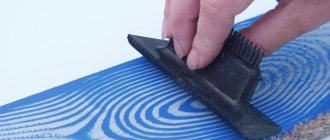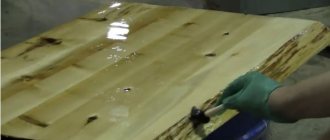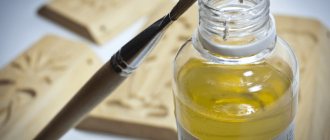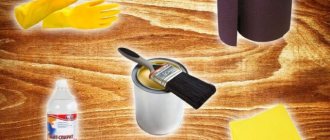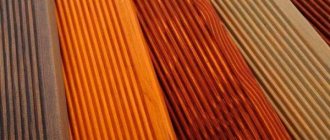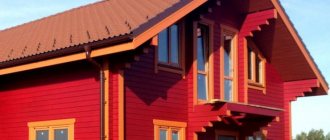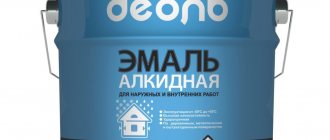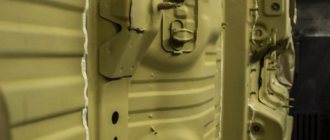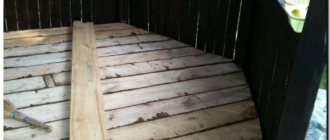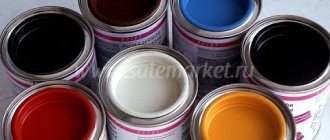Protecting wood from mold, rot and bugs is the primary task of any owner of a wooden house or log house. This question is very important if you are working with wooden products that will later be used outdoors. Homemade homemade furniture also needs protection from moisture and other negative natural factors.
Coal oil is considered the best way to impregnate wood. But it is used only for impregnation of sleepers or other objects operated in harsh conditions. For independent work, use more affordable and pleasant-smelling compositions.
Oil or wax?
Both of these substances are used to protect wood from moisture, mold, mildew, rot and bugs. Both oil and wax have been used since time immemorial and always show good results. They improve the appearance of the tree and increase its strength and service life.
Impregnating oils for woodworking have high antiseptic properties and penetrate deeply into the wood structure, making its surface elastic . They protect the wood from drying out, do not clog the pores, allowing the surface to breathe, and regulate humidity. Wood oils are harmless to humans and are considered the most environmentally friendly way to protect them, along with wax.
Of the oils most often used for self-impregnation of wood, the following can be noted:
- tung;
- teak;
- tar;
- flaxseed
Some people prefer to use oil such as sunflower to impregnate wood. However, it gives the worst effect. The reason is polyunsaturated fatty acids: there are extremely few of them in sunflower.
Waxing is the oldest way to protect wooden products from moisture penetration. Wax fills the pores of the wood and gives it a matte color. Its only drawback is the lack of “breathing” of the treated wood.
Important! It is not advisable to work with pure wax, so it is dissolved in vegetable oil, for example, linseed, plus other additives (turpentine) are included in the composition. This type of work takes quite a long time. Therefore, impregnation of wood with oil compounds is considered the best option for protecting it from moisture, rot, and mold.
Pros and cons of oil for wood processing.
Treating wood with oil-based compounds has many advantages. This:
- environmental cleanliness;
- aesthetic appearance of processed products: oiled surfaces after good polishing acquire a matte shine and become velvety to the touch;
- ease of processing;
- availability of material;
- relative cheapness;
- rapid restoration of mechanical damage. It is enough to re-treat furniture or floors/ceilings/walls and the scratches will immediately disappear.
Oil impregnation will be an ideal protection option for products made of expensive/exotic wood, houses/buildings made of logs (log houses), furniture that is exposed to moisture.
However, oil impregnation also has disadvantages:
- Surfaces are quite demanding to maintain. This applies to both furniture and floors, ceilings, and walls. They need to be impregnated every 3 to 4 months and then thoroughly polished.
- Oiled surfaces are vulnerable to grease. Its stains are clearly visible. Repeated processing removes them
Tung oil.
This is an ancient product used to protect interior wood surfaces from moisture, rot and wood-boring beetles. It can be used to impregnate floorboards, ceilings, wooden furniture, trim and even dishes.
Important! During the Tsarist reign, tung oil was used to finish especially valuable types of wood, from which unique interior items were made. This is due to its amazing ability to very quickly penetrate the surface layer of wood, maximizing its texture.
Before starting work, tung oil should be mixed. It is best to work at an air temperature of +15° C. At a lower value, the composition thickens, and its consumption increases accordingly (standard amount per square meter is 100 - 150 g). Application is done in a very thin layer with a brush. Then let the oil soak in (20 minutes), take a sponge or soft cloth and rub the residue into the wood along the grain. Excess is removed. To increase absorbency, you can dilute tung oil by 40 percent with white spirit. The product is ready for use within a day.
Important! All oily used rags are disposed of as household waste. Grease can be washed off your hands with warm soapy water.
Teak oil.
This is a universal product. It can be used to process both internal wooden surfaces (floors, ceilings, decorative items, railings, stairs, etc.) and external ones (facades, gazebos, garden furniture, decorative figures for landscape design). Ideal for processing products made of oak, mahogany, beech and other valuable wood species.
Teak oil is an environmentally friendly product. It contains tung and linseed oils, purified pine turpentine. It has nothing to do with the tree of the same name (teak).
Important! Never dilute teak oil! Before use, stir it well and/or shake the jar.
Important! The product has proven itself well in damp rooms, so it can be used to treat valuable wood in the bathroom.
Tar oil.
It is one of the most powerful natural antiseptics for DIY woodworking. It contains stump resin, pine turpentine and linseed oil. Turpentine improves the penetration of the composition deep into the wood, linseed oil retains it, preventing it from reaching the surface. The composition is actively used for treating the bottoms of boats and piers. It is also used for external impregnation of log buildings, garden houses and garden furniture.
The properties of tar oil are similar to those of teak and tung. It provides excellent protection to wooden surfaces from moisture, rot and wood-boring beetles, while giving the wood a transparent texture. The technology of work is the same as for tung and teak oils: for 1 m2 of a well-sanded surface, only 100 - 150 ml of product is required. To impregnate the walls of a log house you need from 5 to 10 liters per square meter.
The impregnated surface dries up to 7 days. The drying time depends on both the quality of the wood and the environmental conditions. When applied in one layer, drying time is only a day. Dilution is not allowed; thorough mixing is required before use!
Advice! Store tung, teak and tar oils in tightly covered containers in a cool, dry place. They are not afraid of freezing and retain all their properties in frost.
Linseed oil.
It is rightfully considered the best and cheapest means for protecting wooden surfaces. Flaxseed oil has high waterproofing qualities and is intended for treating external and internal surfaces. It can be used to impregnate wooden facades, walls, ceilings, trim, furniture and other wooden interior items; it perfectly reveals the wood texture, penetrates into the smallest cracks, preserves the wood, creating a durable water-repellent layer on its surface.
During impregnation, linseed oil thickens under the influence of environmental factors (low temperature, oxidative processes). The triglycerides it contains – linoleic and linolenic acids – actively contribute to this.
Important! Flaxseed oil dries longer than all of the above - up to three weeks, depending on the number of layers. If you add tar, wax or turpentine to it, the process can be speeded up.
Offers from manufacturers for different types of work
- Teak and tar oils from Tikkurila are used for outdoor work. They protect the facades of houses.
- Natural compositions of the Osmo company and oil with wax Aquatek balm are used as finishing protective material indoors. The main criterion for their selection is the absence of toxic components in the composition.
- Osmo White Wood Coating Oil with Hard Wax contains white pigments. The coating is carried out in 2 layers. Pine and beech are especially beautifully painted. Each layer is polished.
- The product of the company TM GOODHIM has proven itself well. It is used as an interior material. The composition allows restoration work to be carried out on the damaged area without repolishing the entire wooden object. To do this, it is applied to the damaged area and rubbed until the boundaries disappear.
- Water-repellent material from the Russian manufacturer Neomid is recommended for rooms with high humidity. They protect baths and saunas from moisture and dirt.
- The boards on the terrace are treated with impregnation from the Belinka brand. This is a weatherproof material.
- Neutral antiseptic from Tikkurila is used to protect the lining.
Oil impregnation for wood processing at home.
Let's look at this process using linseed oil as an example, as it is the cheapest and most accessible to the average craftsman. To work you will need a small list of useful things:
- natural hair brush, foam sponge, soft rag, rags;
- oil, a stick for stirring it;
- construction hair dryer, metal brush - to remove old coating;
- sandpaper to bring the surface to a perfectly smooth state;
- broom for removing dust from the surface;
- gloves to avoid getting dirty.
Impregnation technologies.
There are different ways to oil wood. Some people prefer smearing and further rubbing, while others prefer soaking. True, the second method is suitable only for small objects - decorative dishes, figurines. The dish, by the way, can be used (as a container for bread, salt/sugar, fruit) because it is not at all afraid of water.
Preliminary stage.
An important stage of work before impregnation will be the preliminary preparation of external/internal surfaces. For boiling, you will need to thoroughly sand the dishes or figurines . They are supposed to be freshly carved from wood and not covered with anything on top. Otherwise, you will have to remove both paint and varnish, and this is a very tedious task.
For large areas (walls, floor, ceiling) you will have to do much more:
- Rip off the old coating. This includes varnish and paint. Use a wire brush or spatula for cleaning. If the paint does not want to come off, heat it with a hair dryer. When it bubbles, lift the layer with a spatula and remove.
- Sand the surface. Use two types of sandpaper for this – coarse and fine. You can stop cleaning when you feel a smooth surface without flaws under your hand.
- Remove dust. Brush it off with a soft (Vietnamese) broom or use a regular rag. There should be no dust remaining on the surface before oil impregnation.
Coating.
The easiest way to protect wood from moisture and rot is to oil it. It's best to do this with a rag. But you can also use a brush with natural bristles. This is relevant for small areas (platbands). Impregnate internal/external walls, ceiling or floor with a soft cloth soaked in oil. This is done as follows:
- Stir the product and pour some into a separate container.
- Dampen the rag and start soaking. Apply the composition along the fibers.
- Leave the oil for 15 - 20 minutes. Then remove the residue with a rag.
- Allow the surface to dry, then repeat the treatment.
Soaking.
This method is used for small products. Pour oil into a container and place the pre-cleaned wooden product in it. The holding period is not limited. Ideally, you need to hold a plate, figurine, knife or gun handle until air bubbles stop escaping from the wood.
After this, take out the item and place it on a table covered with clean paper, tilted, so that excess oil drains off. Then take a rag and polish. Pure linseed oil without additives takes a long time to dry - up to 3 weeks. This has its own advantage - the depth of such impregnation is great, and the tree receives excellent protection from moisture, rot, and mold. If you can't wait to see the finished product, add beeswax to the linseed oil. This will significantly speed up the process.
Recipe for oil/wax composition based on linseed oil (suitable for both external and internal surfaces):
- Heat the oil until smoking.
- Pour grated wax into it.
- Stir. When the wax dissolves, pour the mixture into a jar.
- To give the mixture a pleasant aroma, add a few drops of juniper oil.
DIY painting mistakes
Often, unprofessional craftsmen, having received superficial information from the Internet about oil application technology, perform the work themselves. This inevitably leads to errors in work, which affect the quality of painting.
Below are typical mistakes that non-professionals often make:
Violation of technology. Despite the fact that in general the process of applying different types of oil is the same, each impregnation has its own unique composition, which introduces certain nuances into the rules for treating wood with this product. Insufficient surface preparation. Many people do not pay due attention to the preparatory work, do not clean off the old coating well, do poor-quality sanding, and leave uneven spots and cracks. As a result, after applying the oil, all defects come out, which greatly deteriorate the appearance of the coating. Carrying out work at high wood humidity. Humidity is a very important indicator; if you apply oil to undried wood, the impregnation will not be able to penetrate into the deeper layers and provide full protection. Delays or rushed work. Unfortunately, this mistake is often made by contractors.
Compliance with the timing when applying the coating is very important. The first layer must sufficiently saturate the surface before applying the next one. In this case, it is also important to apply a second layer until the surface is covered with dust and dirt.
After all, wood undergoes deep cleaning before painting and should not be left unprotected for a long time. may cause problems with painting technology.
To avoid these and similar mistakes, contact professionals. has more than ten years of experience in finishing and processing wooden houses
Our company pays special attention to quality; all work is carried out under strict control by the technical supervision department
We are official dealers of well-known manufacturers of professional products based on linseed oil Osmo, Remmers, GNature, Biofa, Wooden Wood, Ramsauer, thanks to which we can provide special conditions for our customers. When ordering home treatment with oils from these manufacturers, the cost of the products is calculated at the wholesale price.
Our partner is also the law firm Help Consulting. This is a team of specialists focused on disputes in the construction industry. We always recommend this company to our clients who have fallen into the hands of charlatan builders. If suddenly your choice is not with our company, then before making payments and making advances to the contractor, conduct a legal analysis. This will help save you hundreds of thousands of rubles.
We provide services in Moscow and neighboring regions, to leave your request, contact us using the coordinates on the “Contacts” page.
Calculate the cost of painting and insulating your home right now
Do you have accurate measurements of the house?
I measured it myself. I have a house design. Measurers came. I want to call a measurer.
By clicking on the button, you consent to the processing of personal data
How to insulate an attic or loft yourself
Treatment of wooden surfaces with Biofa oil – protection and preservation of texture
Features of Osmo oil - types and application technologies
Sealant for wood Axton from Leroy Merlin
